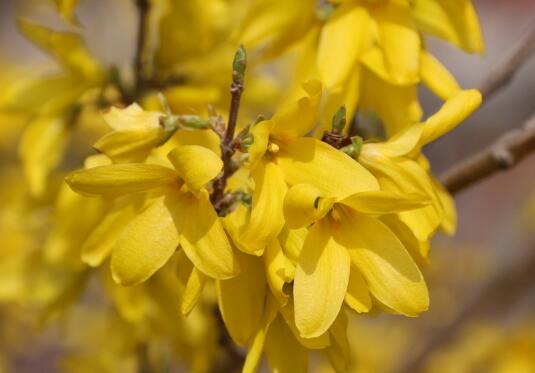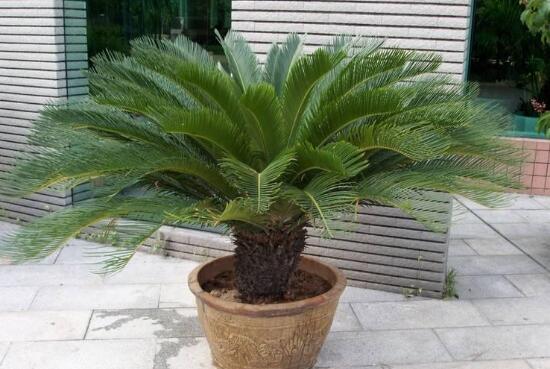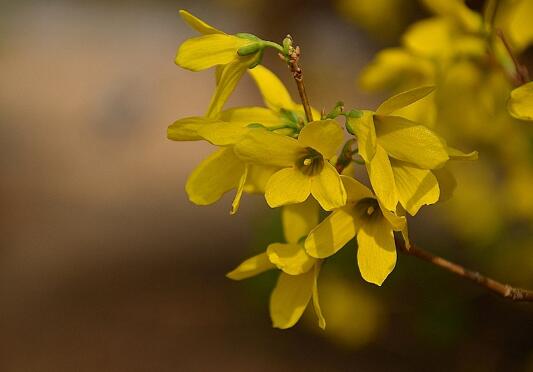How to raise Forsythia suspensa, the culture methods and precautions of Forsythia suspensa / avoid stagnant water / avoid bright light
The city flower of Forsythia suspense in Seoul, the capital of South Korea, is highly ornamental. Nowadays, there are many people raising it in various regions of our country, but if you want to raise it well, there are many places that need to be paid attention to. About how to raise forsythia? What are the breeding methods and points for attention of Forsythia suspensa? Next, the editor will take you to learn about it.
First, how to raise Forsythia suspensa and understand its habits

If you want to know how to raise Forsythia suspensa, we must first understand its growth habits. This plant likes light, but is not resistant to strong light, so it is best to raise it in the semi-shade when the sun is strong. In addition, daily water and fertilizer management is also a top priority for it, must be in accordance with the requirements, the details are described below, let's take a look.
2. Culture methods and matters needing attention of Forsythia suspensa
1. Humus soil
Before we cultivate Forsythia suspensa, we first need to choose soil. Although this plant does not have high requirements for soil, it is very helpful to choose a suitable soil for its growth. Generally speaking, it is best to choose loose and fertile humus soil. This kind of soil has good drainage and air permeability, so it is not easy to have stagnant water.
two。 Fertilization, once every 15-20 days
Fertilizer is one of the main nutrients in the growth process of Forsythia suspensa, especially after entering the growing period, its demand for fertilizer is very high, basically every 15-20 days or so. However, there is one thing we should pay attention to when applying fertilizer, the fertilizer must be diluted before fertilization, if the concentration is too high, it is easy to burn the plant.
3. Moisture, avoid stagnant water
When we cultivate Forsythia suspensa, the soil should not be too dry, to maintain a certain degree of humidity, so we need to water frequently. However, we should pay attention to the amount of water, remember not to cause stagnant water, otherwise it is easy to cause rotten roots, and we should also pay attention to drainage during the rainy season.
4. Light, avoid strong light
Forsythia is a plant that likes light, but is not tolerant to strong light. In spring and autumn, because the light is not suitable, we can put it outside to receive light all day, but after entering summer, because the light is strong, so we had better move it to indoor semi-shade to cultivate it so as not to burn the plant.
5. Regular pruning
In the process of cultivating Forsythia suspensa, we also need to prune it regularly to cut off some overgrown branches and some withered, diseased and weak branches, which can not only facilitate the ventilation and light transmission of the plant, but also promote branching, so that Forsythia suspensa can grow better.
6. Prevention and control of diseases and insect pests should be timely.
In the growth process of Forsythia suspensa, if we do not maintain properly, it is easy to have diseases and insect pests, and this kind of problem is very harmful to the plant, so we must deal with it in time when it is found, because the longer the time drags on, the greater the harm to the plant. The specific treatment methods are introduced in detail in the article on the prevention and control of diseases and insect pests of Forsythia suspensa.
Bamboo begonia, also known as Cigu begonia, is a flower plant belonging to the genus Begonia of the begonia family. It is a perennial sub-shrub plant, because the stem of bamboo begonia is very similar to that of bamboo, so it is called bamboo begonia. The color of its leaves is green, and when the flowers are in full bloom, they are bright red, drooping in clusters, very beautiful in posture, and very gorgeous, suitable for breeding in a warm environment, with a very good ornamental effect. It usually blossoms from April to November every year. Let's take a look at the culture methods of bamboo crabapple, and why the leaves of bamboo crabapple withered. [morphological characteristics of bamboo begonia] Bamboo Begonia is an erect and scattered subshrub plant, its height is generally 0.7-1.5m, it is smooth and bald, and it has many branches. There are many obvious bamboo shapes in the stem, showing the shape of a single leaf, while the petiole is 2-2.5cm in length, cylindrical in shape, purplish red in color, and very thick in leaves. It is oblong or oblong in shape, with a length of 10-20cm and a width of 4-5cm, with a heart-shaped position at the base, a light wave point shape at the edge, dark green above, and most round white spots, while the north is crimson. The color of the flower is light rose, with white, the inflorescence is Cymes hanging in the axils, the flower is lanceolate, and it will fall early. The flower is erect, the ovary is inferior, and the fruit grows. [growth habits of bamboo crabapple] Bamboo crabapple likes to grow in a sunny and moist environment, and its shade tolerance is very good. It is suitable for growing in fertile, loose, very good drainage soil, and has a certain degree of cold resistance. In winter, need to be put in indoor farming, the appropriate temperature is 5 degrees Celsius, and will always keep the feeling of bright green. Its growth habit is relatively strong, it is very suitable to be cultivated as a family plant, and has a very good ornamental value. In daily life, it often appears in parks and flower beds and is suitable for potted plants. Bamboo crabapple is native to Brazil. [propagation method of bamboo crabapple] the propagation method often used by bamboo begonia is its cutting propagation method, which can also be used in split propagation and water cutting propagation. Choose the cutting method to choose the note Oh ah robust twig as the cuttings plant, cut off 10-15cm with 3-4 segments of the plant, and the lower part of the incision is in the lowest section 0.5cm is the most appropriate, generally need to cool for a day. Leave 2-3 leaves, the water of the breeding plant is evaporated, then spray water, first propagate in a cool place, wait until it takes root before transplanting. [culture method of bamboo crabapple] Bamboo begonia is a kind of shallow-rooted plant. It likes to grow in a half-shaded, half-cool and humid environment. It is not particularly cold-resistant, avoiding sun exposure, high temperature and waterlogging weather. The temperature suitable for growth is 15-25 degrees Celsius, its cold resistance is very strong, afraid of stagnant water, like to grow in a loose, fertile, good drainage environment. Generally speaking, it is necessary to maintain the principle of watering dry and wet. 1. Fertilization: sufficient fertilizer can make bamboo crabapple thrive, which can be carried out when the basin soil is relatively dry, and can be reduced appropriately after fertilization, so that the plant can better absorb water. Thick fertilizer should not be applied when the stems and leaves are less exuberant. Generally, in the spring of the growing period, a thin liquid fertilizer is applied once in half a month. In the summer high temperature season, the plant is in a dormant state, so it is necessary to reduce the amount of fertilizer applied, and stop fertilizing when the flowers are in full bloom and in winter. This is more conducive to plant growth. two。 Watering: bamboo crabapple is a kind of plant that is afraid of wetting. Keep the basin soil moist in summer and growing period, but avoid stagnant water, otherwise it will cause root rot. In the summer of color, we should not only irrigate enough water, but also need to maintain the wettability of the basin soil, which is more conducive to the blooming of flowers. 3. Lighting: bamboo begonias like to grow in a dark and warm environment, afraid of direct sunlight, give plenty of sunshine in spring, autumn and winter, and avoid direct sunlight in summer, otherwise the plant will turn yellow. and the growth rate will slow down. 4. Pruning: if you want to maintain the ornamental value of bamboo crabapple, it is necessary to properly prune the potted plant, trim off the plants that are taller and have fallen leaves on the stem, otherwise it will affect the plant of bamboo crabapple. Proper pruning during the Spring Festival is more conducive to the sprouting of new branches, and the flowers are in full bloom. Why the leaves of bamboo crabapple withered. It can cause the leaves of bamboo crabapple to wither at high or low temperature. It likes to grow in a warm and humid environment, the most suitable temperature for growth is 15-18 degrees Celsius, its cold resistance is not very good, generally at 5 degrees Celsius leaves will fall off. In high temperature, when the temperature is above 30 degrees Celsius, the plant will be in a semi-dormant state, if not careful care, the leaves will fall. two。 Growing in bright light or in an overly dark environment can cause the leaves of bamboo begonia to wither. Bamboo crabapple likes to grow under warm astigmatism, and its leaves are too strong in summer, which will cause the leaves to wither or yellowing. In the case of insufficient light, it will also cause leaves to fall, and plants and flowers will also grow too much. 3. If it is too dry or too wet, it will wither the leaves of bamboo crabapple. Bamboo crabapple can not grow in a too humid environment, otherwise it will cause root rot, thus affecting the ability to absorb nutrients, resulting in the withering of its leaves. When the temperature is relatively low in winter, the amount of water should be controlled.
More information about yellow leaf forsythia picture Caragana picture how to grow rhododendron picture buttercup picture
- Prev

How to raise the iron tree, the cultivation methods and precautions / light of potted iron tree should be sufficient.
For the iron tree, flower friends should have heard of it, its beautiful tree shape, green leaves, evergreen four seasons, is a widely acclaimed foliage plant. In life, because the iron tree is very effective, so many people want to raise a pot at home, how to raise the iron tree? To this
- Next

How to water forsythia, how to fertilize forsythia / control the amount of water / apply thin fertilizer frequently
Forsythia suspensa is a kind of flower plant with high ornamental value, which can be seen in many areas of our country, and this plant can be planted in pot or in a large area. However, if we want to keep it well, there are many things we need to pay attention to, among which the daily water and fertilizer management is the most important.
Related
- Fuxing push coffee new agricultural production and marketing class: lack of small-scale processing plants
- Jujube rice field leisure farm deep ploughing Yilan for five years to create a space for organic food and play
- Nongyu Farm-A trial of organic papaya for brave women with advanced technology
- Four points for attention in the prevention and control of diseases and insect pests of edible fungi
- How to add nutrient solution to Edible Fungi
- Is there any good way to control edible fungus mites?
- Open Inoculation Technology of Edible Fungi
- Is there any clever way to use fertilizer for edible fungus in winter?
- What agents are used to kill the pathogens of edible fungi in the mushroom shed?
- Rapid drying of Edible Fungi

